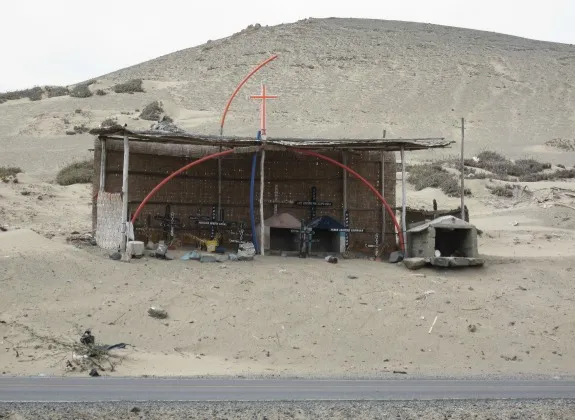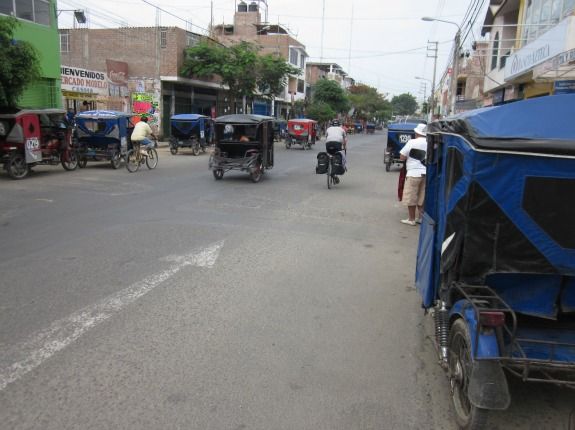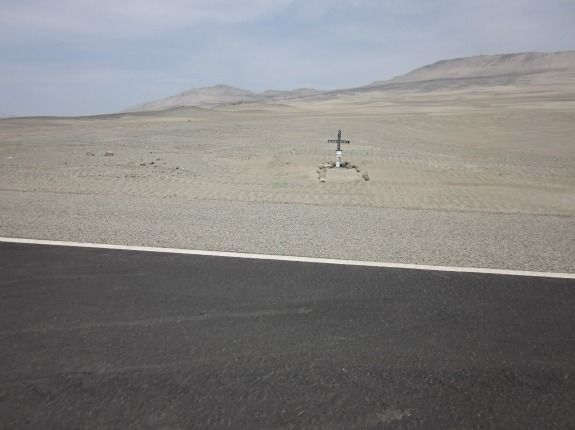Braving the Pan-American Highway of Death
Along the roadway in Peru, hand-built memorials to accident victims occur almost as regularly as the kilometer markers themselves
/https://tf-cmsv2-smithsonianmag-media.s3.amazonaws.com/filer/20130115122108PeruSkeleton3SMaLL.jpg)
Virtually nothing lives in much of the dusty, rocky sweeps of desert along Peru’s coast. But as evident as the mere absence of life is the prominent mark of death along the sides of the Pan-American Highway—hand-built crosses occurring almost as regularly as the kilometer markers themselves. They stand coldly in the sand bearing the names and dates of death of accident victims. The crosses are too numerous to count, but there are certainly thousands of them. That this highway is so stained by blood doesn’t surprise us. The truck traffic is heavy and aggressive, buses race wildly north and south lest they reach their destination late by a few minutes and cars honk first and brake later. These reckless vehicles share the road—well, they use the same road, anyway—as three-wheeled moto-taxis, donkey-drawn carts, motor bikers, pedestrians and a few cyclists. We move to the gravel shoulder when we hear large vehicles approaching from behind, for if the abundance of roadside death memorials tells us anything it’s that no drivers on the Pan-American should be fully trusted. In one village, I saw a cross scrawled with a death date just two months prior. Two-hundred meters away was another marking a fatal accident last April. The heavy presence of death, it seems, never quite leaves this place.
Just ten kilometers north of the town of Casma we passed a small woven-bamboo shack with an open side facing the road. Inside were more than a dozen crosses. Each person, it appeared, had died on the same day—August 13, 2005. Some later research revealed that this was the date of a horrific bus-truck collision involving some local commercial fishermen and a vehicle carrying flammable liquids. The crash resulted in an explosion, and 14 people died.

Just several kilometers later I caught a glimpse of something more ghastly on the west side of the highway. I turned around and crossed over and leaned my bike on the dune and stared. It was a human skeleton, bones splintered and smashed and roughly assembled before a crude headstone stuck in the sand. Beside the bleached bones lay the greater portion of the person’s skull, accompanied by a tangle of long brown hair. Andrew had also turned around by now and come back to join me. After a few moments we took several photos, then left to hunt up dinner and a place to sleep in Casma. We asked a local man about the two sites. He said the first was the memorial to a crash three years ago in which 24 people died in an explosion—not quite accurate, but the same general story we gleaned off the Internet. And the skeleton? He shrugged. Probably some crazy person. “Do the police not care or come and collect the body when vagrants die?” I asked. Again he shrugged and said that authorities tend not to bother here with accidents or deaths that go unreported. Still, we wondered why the bones were so broken to pieces (both of the lower legs were entirely snapped, and the back of the skull was knocked out) and, of course, who had taken the effort to assemble the remains as we found them.

Though the crosses along this roadway serve as a constant reminder of what bad driving can do, many, many people both on the Pan-American and on city streets drive recklessly, brazenly shirking basic courtesy and caution. We frequently must stop in the middle of intersections for drivers who refuse to yield in making left turns. The “right hook” is another popular move, by which motorists cut sharply in front of us, then make a quick right, forcing a complete stop on our part and often leaving us in a choke of dust. The honking is incessant—though not solely an act of aggression: laying down the horn in another’s ear also seems to be the way that gentlemen say hello in Peru. Still, the rude racket does little to calm our nerves. Within the towns, three-wheeled moto-taxis swarm like bees. They leap over speed bumps and push through the narrow walkways of outdoor markets. Their horns make strange beeping-bleeping noises, and they zip about with a curious insect-like demeanor. Moto-taxis have been the culprits in vehicle-pedestrian deaths, though on the open road (in the places where they are permitted) they hug the shoulders, like us, and are as vulnerable as we are to the giants of the highway. Sadly—or maddeningly—most accidents here could probably be avoided. One article names human error as the cause of 83 percent of Peruvian auto accidents. According to the same story, 3,243 people died in Peru in vehicle accidents in 2009, with more than 43,000 people injured. Another article reports that traffic accidents are the leading cause of death among children ages 5 to 14, and second among people 15 to 44.
We took a bus from Chimbote to Chiclayo. I have never been particularly frightened during bus rides—but this was no ordinary bus ride. We were seated in the upper deck in the front row, which gave us a prime view of the highway madness that unfurled before us. Our driver was an efficient man, concerned with each half second that went by. He swerved into oncoming traffic to overtake slower vehicles and gain a few seconds of time. He ran smaller cars off the road and angrily blared his horn to show who was boss. While we momentarily tailgaited a slow and lumbering gravel truck, waiting for an opening, another bus passed us and the truck—and had a very close call with an oncoming tanker, probably carrying flammable liquids. Horns blared north and south as the tanker took to the shoulder. Andrew and I covered our eyes and watched through our fingers. A moment later, we overtook the same bus. Beside us was a buoyant, spirited man bouncing his little boy on his knee as the desert highway blew past. What a ride! Night came, and each oncoming car became just a pair of blinding headlights. Our only consolation came from knowing that if we did connect with a sedan or pickup, this bus would smash it to pieces. Flying past us regularly were the roadside crosses, illuminated in the bus’s headlights but having no obvious effect on our driver’s actions.
We reached our destination at 9 p.m.—right on schedule—and we couldn’t complain about that. Or could we?

Planning Your Next Trip?
Explore great travel deals
Smithsonian magazine participates in affiliate link advertising programs. If you purchase an item through these links, we receive a commission.
/https://tf-cmsv2-smithsonianmag-media.s3.amazonaws.com/accounts/headshot/Off-Road-alastair-bland-240.jpg)
/https://tf-cmsv2-smithsonianmag-media.s3.amazonaws.com/accounts/headshot/Off-Road-alastair-bland-240.jpg)